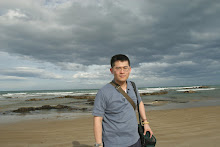No. 16 Beach in Rye is known, of course, for its Dragon Head Rock — that craggy silhouette rising from the restless sea like an ancient sentinel carved by wind and tide. Yet it is not only the famous formation that holds the eye. What fascinated me more that day was the exposed ocean floor, revealed in shifting patches as the waves inhaled and exhaled. Ridges of kelp, stone, and sand emerged like the ribcage of the earth itself, each glistening plate a quiet record of centuries of tides, storms, and moonlit nights. Here, the sea writes its diary in saltwater ink.
Joel and I lingered on the shoreline, lingering in the breeze that smelled of brine and age. Our footsteps pressed into sand that had once been sacred to the Boon Wurrung people, the traditional custodians of this stretch of the Mornington Peninsula. For thousands of years they moved along these windswept dunes and coastal flats, gathering shellfish, watching the migration of birds, reading the tides with an intimacy that modern visitors can only imagine. Long before the beach became a photographer’s haven, it was a living classroom, a place of food, ceremony, and story.
Later came the early European settlers, carving tracks through the tea-tree, building fishing huts, and naming the headlands after their own imaginings. The coastline remained wild and ungovernable, storms reshaping its contours with a kind of untamed artistry. Dragon Head Rock itself became a marker for sailors and wanderers — a creature hewn from basalt, watching over the changing generations.
As Joel and I took in this layered landscape, the unexpected happened: a photography group we had once been part of — a group with which the past included frictions and small wounds — wandered into the same stretch of beach. The air, suddenly, felt taut. Once, we had met weekly under the casual banner of shared interests, but the structure frayed when the leader, who struggled with memory impairment, continued to collect a five-dollar annual membership fee as if time had not moved on. Misunderstandings grew. Intentions tangled. A minor sum became a symbol of something heavier — a discomfort none of us knew quite how to name.
Seeing them again here, the old tension rose like a shadow across the sand. Yet it was oddly softened by the scenery. The roar of the waves seemed to dwarf the awkwardness, reminding us that human discord is fleeting compared to ancient coastlines. Dragon Head Rock did not care for our quarrels. The exposed ocean floor continued its shimmering revelations, indifferent to the knots of memory and missteps that people carry.
In that moment, the past felt like another tide — rushing forward, pulling back, reshaping what we thought we understood. And the beach, wise and wide as ever, held all of it: the history of land and water, the footprints of those who came before, and the small human stories that drift through like foam on the surface of a much older sea.
Sony A7RV
FE 20-70mm f4 G
Linking Sunday Best



























